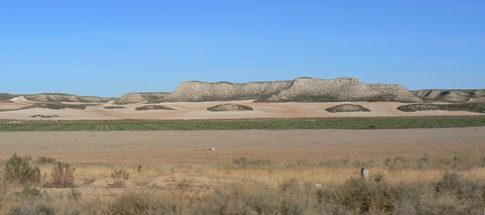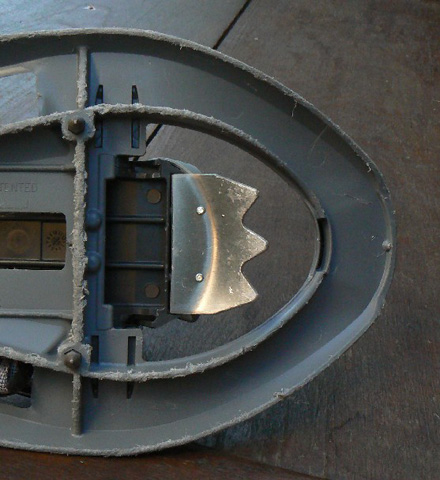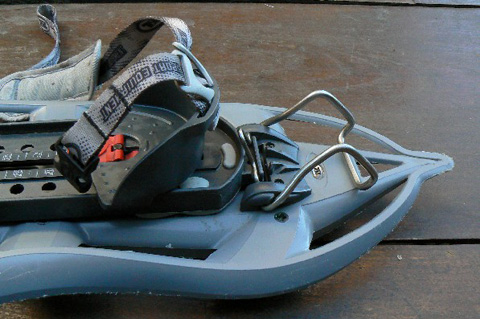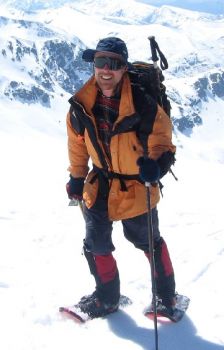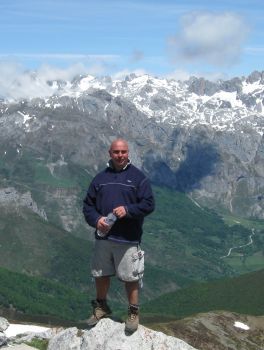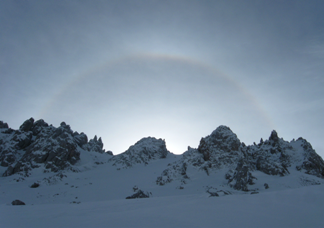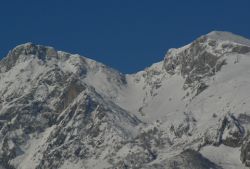Biscay
- Article Count:
- 1
Bay of Biscay
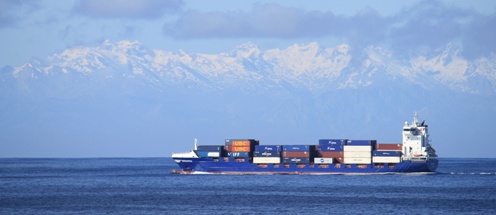
As I make the ferry crossing fairly regularly between Santander and Plymouth (Brittany Ferries) I thought it would be nice to keep a record of my pelagic wildlife sightings here.
- Article Count:
- 3
Picos Holiday Rentals
Our selection of places to stay in and around the Picos de Europa, northern Spain
- Article Count:
- 0
Asturian properties

Picos Holiday Rentals offer a selection of self-catering places to stay in and around the Picos de Europa, Asturias.
Click on the images below to go to that property's page, towards the bottom of which you'll also find a clickable map to see exactly where each village lies. Please use the links provided on each property's page to contact us for checking availability or asking for more information.
- Article Count:
- 3
Cantabrian Properties
 Picos Holiday Rentals offer a selection of self-catering places to stay in and around the Picos de Europa, Cantabria.
Picos Holiday Rentals offer a selection of self-catering places to stay in and around the Picos de Europa, Cantabria.
Click on the images below to go to that property's page, at the bottom of which you'll also find a clickable map to see exactly where each village lies. Please use the links provided on each property's page to contact us for checking availability or for more information.
- Article Count:
- 5
Castile-Leon Properties

Picos Holiday Rentals offer a selection of self-catering places to stay in and around the Picos de Europa, León.
Click on the images below to go to that property's page, at the bottom of which you'll also find a clickable map to see exactly where each village lies. Please use the links provided on each property's page to contact us for checking availability or asking for more information.
- Article Count:
- 1
Anuncios
- Article Count:
- 1
Wild Flowers
One of the reasons the Picos de Europa was made a National Park, and more recently a Unesco Biosphere Reserve, is its hay meadows. Flowers abound in these traditionally-managed pockets of colour before they're cut in June. From April/May to September/October botanists can also head higher to the splendours of the alpine pastures and natural rock gardens to find the myriad flowers there among the limestone peaks. Some plants are endemic to the Cantabrian mountains and a few to just the Picos de Europa themselves.
See also Orchids
- Article Count:
- 4
Orchids

It's not only pollinating insects that are attracted to the Picos de Europa in spring by the array of colourful, ingeniously developed orchids growing here. Botanists from all over the world come to study the hay meadow habitats that contribute to making the Picos de Europa so special. N.B. Groups are advised not to walk through the middle of hay meadows when these are about to be cut. Please keep to the edges so as not to flatten the crop!
From the first exhuberant, early-flowering displays of Giant orchids in March through to the more diminutively demure Autumn lady's tresses in September, orchids can be found, however, not only in the most commonly-known months of May and June, nor only in the hay meadows. The different soil types around the Picos, from alcaline calcareous to acid, provide the ideal growing media for a variety of orchid species. The range of altitudes from about 100m - 2,000m+ further explains why around 50 terrestrial orchid species have been recorded so far in this compact mountain range.
Following is an alphabetical list (common English names) of the Orchidaceae species that I've seen. Delving further you'll find descriptions, photos, scientific and common English and Spanish names of each, when they exist. In an effort to avoid the taxonomic jungle and to give the latest, generally accepted scientific names, I have followed Flora Ibérica, Castroviejo, S. (2005), Royal Botanical Gardens (CSIC), Madrid.
- Article Count:
- 7
Around the Picos
- Article Count:
- 0
San Glorio
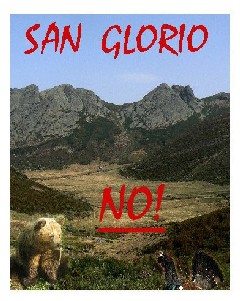 In 2006 I first became aware that what I'd believed to be a ridiculous rumour was, in fact, a very real possibility. Promotors had found a construction company prepared to build another ski resort in the Cantabrian mountains even though the existing three run at a loss. Incensed by the lack of foresight of this project, and the willingness of the local populace to back it, I started an online petition to garner support for opposing the barbaric and arrogant attitude of people that believe that this land is theirs to destroy. Anyone who has seen a ski resort in summer can testify to the ugliness of ski lifts, pylons and pistes without the covering of snow.
In 2006 I first became aware that what I'd believed to be a ridiculous rumour was, in fact, a very real possibility. Promotors had found a construction company prepared to build another ski resort in the Cantabrian mountains even though the existing three run at a loss. Incensed by the lack of foresight of this project, and the willingness of the local populace to back it, I started an online petition to garner support for opposing the barbaric and arrogant attitude of people that believe that this land is theirs to destroy. Anyone who has seen a ski resort in summer can testify to the ugliness of ski lifts, pylons and pistes without the covering of snow.
I've already written a fair amount on the San Glorio ski resort project on the IberiaNature forum.;
"The project for a ski resort in the mountains of Leon, Palencia and Cantabria (San Glorio) is still being stalled by environmental reports and conservation groups. Apart from the destruction of these mountains with all the building, piste-making, huge car parks, etc. and the contamination of soil and rivers with artificial snow-making, the project would mean the end of the Iberian brown bear in these territories by removing a very important corridor of access between the two surviving population pockets. The majority of the local population are under the impression that the project will bring hordes of piste skiers to their region whereas the reality is that these mountains are relatively low compared to the Pyrenees and the Alps, with uncertain snow conditions and high winds."
Here I try to make sense of the sorry saga and keep up to date with the latest developments.
Imagine a poor rural community ekeing out an existence from subsistence farming and living off the land and all that it provides. Now add the tourism boom that Spain enjoyed in the latter half of the twentieth century. What other recourse could the mountains provide to boost the impoverished economy of these people? Winters were harsher then with snow lying much deeper, according to the locals. A ski resort could halt the rural depopulation, provide work and keep the young at home.
Now imagine a land devastated by diggers, disfigured by chairlifts and pylons, rivers drained, wildlife displaced or, at the worst, made extinct, and a human population disillusioned because the promised ski resort turned out to be a white elephant due to adverse weather conditions and climate change.......
While we're at it, we might as well imagine the government of an autonomous community humiliated and voted out of government due to illegal activities (such as the manipulation of laws created to protect the environment) to satisfy their own greed.......No, you're right. That's just taking wishful thinking to the extreme.
If you who don't know these mountains, here's a short film....
- Article Count:
- 5
Cantabrian Mountains
The Cantabrian mountains, in Spanish the Cordillera Cantábrica, stretch more or less parallel to the northern coast of Spain running some 500km from the western Pyrenees, through the Basque country, Cantabria, Castille and León, Asturias and into Galicia. They effectively separate Green Spain from the high plains of the Central Meseta and are the reason why the former receives so much rainfall from the prevailing west/north-westerly weather fronts.
They are composed of mostly limestone, conglomerate, shale, quartz, sandstone and granite, giving rise to many interesting rock formations such as this ridge of limestone outcrops that brings to mind the back of a Stegosaurus.
From a distance lumps of conglomerate appear green because of the lichens  growing on the surface.
growing on the surface.
 In places the history of the sedimentary processes and the contortions in the rock are vividly obvious.
In places the history of the sedimentary processes and the contortions in the rock are vividly obvious.
Excluding the Picos de Europa, the highest point in the Cantabrian mountain chain is Peña Prieta, which at 2,539m rises from the central area of these mountains in the province of Cantabria near the border with Castile-León.
See also the San Glorio pages for more on the Cordillera Cantábrica and it's flora and fauna.
- Article Count:
- 1
Cabrales

Cabrales is the Asturian municipality to the north of the Picos de Europa, famous within Spain for its blue cheese of the same name. Naturally bordered on its north side by the Sierra de Cuera and on its south side by the central and western massifs of the Picos de Europa, its main access road is the AS-114 which, coming from the coast, takes you through the valley from its eastern border at Panes and Peñamallera Baja to its western boundary at Onís. 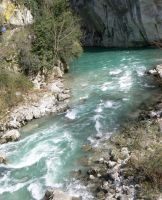
The crystal, blue-green waters of the Cares river accompany the road much of the way. (Locals will tell you it's the most southerly of Europe's salmon and trout fishing rivers, possibly!).
The main towns of the area are Carreña and Arenas ( full names of both suffixed with "de Cabrales"). The former, being the capital, houses the town hall and most municipal services, while the second has a more touristy feel being the gateway to the area's most famous walk, the Cares Gorge. In Arenas you'll find artisan wares, postcards, a post office and trekking clothing. Both towns have bars and restaurants serving fabada (the Asturian version of the French cassoulet), cider and Cabrales cheese, although neither could be described as big. Cabrales' resident population is only around 2,500 people.
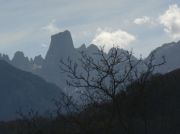
Cabrales can also boast views of one of Spain's most famous mountains, Naranjo de Bulnes. Just outside the village of Poo (de Cabrales), on the main road, there's an ample parking area for the viewpoint. The hamlet of Camarmeña, above Poncebos at the northern end of the Cares Gorge, offers an even closer view. There's now a road up to the hamlet of Camarmeña leaviing the village of Bulnes itself as the only village left in the Picos without road access although the village is now serviced by a steep cog railway built into the mountainside.
The highest village of Cabrales, and the Picos de Europa National Park is Sotres, surrounded by peaks and mountain pasture and accessed by a twisting road with spectacular views.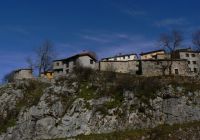
See also Picos Holiday Rentals for accommodation in Cabrales.
- Article Count:
- 1
Wildlife
- Article Count:
- 0
Other Mammals
The Picos de Europa and Cantabrian mountains are home to a very special selection of European mammals. From the shy and rare Pyrenean desman to equally shy 400lb brown bears, there are some 70 species of notoriously elusive mammals in our area including the Iberian wolf and 21 species of bat.
- Article Count:
- 3
Birds
News on birdlife around the Picos de Europa. From sub-adult Lammergeier incursions from the Pyrenees and the possible reintroduction programme to Avocets and Little egrets on the Costa Verde. Also included here are personal observations of resident and summer-visiting birds.
- Article Count:
- 9
Reptiles
Articles on reptiles living around the Picos de Europa. Among the pages here you'll find the largest lizard found in mainland Spain and which snakes to give a wide berth.
- Article Count:
- 1
Bears
All the latest news and articles on the remaining Cantabrian brown bear population of northern Spain. News is translated from the Spanish. Also included are articles on bear ecology, problems of habitat conservation and more.
- Article Count:
- 17
Travels Around Spain
- Article Count:
- 2
Invertebrates
Any botanist out studying in the field can't help but witness the closely symbiotic relationships that exist between so many different species of the insect and plant worlds. The huge current interest in macro and digital photography provides close-up views of previously unseen invertebrate life.
- Article Count:
- 0
Butterflies
Articles on the more than 150 species of butterfly currently identified in the Picos de Europa.
Also included here are some of the species found futher afield in the vicinity.
- Article Count:
- 3
Picos Rock and Snow
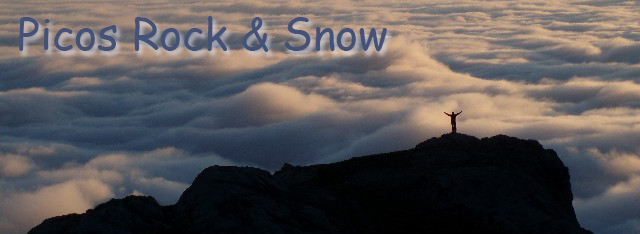
Welcome to Picos Rock & Snow - Guided Walking, Trekking, Scrambling, Snowshoeing, Ski Touring and Splitboarding Holidays in the unspoilt Picos de Europa mountains of Northern Spain with the Picos experts!
Picos Rock & Snow started life as Gustavo Ski Tours in the winter of 1991. The new name now also encompasses our walking, trekking, scrambling and snowshoeing holidays.
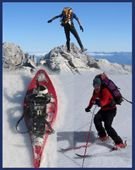 Here's what Mike says;
Here's what Mike says;Read our guests' tales in the trip reports section and Mike's news and accounts in the Picos Blog. Use the tabs below, or the dropdown menu above, to see our choices of activity holidays.
We also offer daily guided walks in the central and eastern massifs of the Picos and in the central part of the Cantabrian mountains from the San Glorio and Piedrasluengas passes, all easily accessible from the area around Potes.
- Article Count:
- 1
Walking Holidays

The maritime limestone pinnacles, dramatic gorges and verdant valleys of the Picos de Europa are wonderful walking country, harbouring a biodiversity that has been lost in much of Europe. Picos Rock and Snow offer guided mountain walking holidays, away from the well-trodden tracks of other walkers, with an English guide who knows the area like the proverbial back of his hand, allowing you to relax completely, to enjoy the spectacular scenery and your own endorphin rush.
Whether you'd like to bag peaks, scramble, stroll by flower-strewn hay meadows, spend nights out in the mountain refuges or take in the whole of the range on a hut to hut trek, we can guide you.
And if you don't want a full week we also offer daily guided walks. Just send us an email here or contact us on +34 660551307.
Picos Rock and Snow walking holidays are based on 3 basic grades -
Level 1 (Gentle and easy)
Level 2 (Moderate - Challenging)
Hut to Hut Treks (Moderate - Challenging)
Also Family Mountains and Beach Holiday
Our holidays are best described as bespoke because these grades are simply guidelines for us to tailor walks suited to your abilities and aspirations. This flexible approach allows the first to book to have a choice between one or the other or a mixture of both. We will then plan following bookings accordingly.
Having lived for twenty-odd years in the Picos de Europa Mike, your guide, has so many walks up his sleeve that he prefers to plan day by day rather than having fixed itineraries, taking the weather into account as well as your own personal preferences.
Our walking weeks run with a minimum of 1 person to a maximum of 14, starting at the end of the winter season, generally sometime in April as the snows melt, continuing through to November when they return.
We offer generous discounts on group bookings! Contact us for more information.
Browse our walking holidays pages via the menu on the right or by hovering your mouse on the Picos Rock and Snow drop-down menu at the top (desktop) or via the walks and treks menu below if you're using your mobile.
Check our walking holidays calendar to see which weeks are available to join or which ones are free to start your own.

- Article Count:
- 7
Ski Touring & Splitboarding Holidays

An Introduction to Ski Touring

So what's the difference between ski touring and ski mountaineering? Basically, ski touring is walking on snow using downhill skis. Ski mountaineering includes the use of ice axe and crampons to take your ski touring a step further, allowing you to strap your skis to your pack (or leave them at the base) and make summits otherwise unattainable. Other terms used are backcountry skiing (U.S. and Canada) and ski randonnée (French Alpine).

To stop you sliding downhill and getting nowhere fast there are skins that stick to the bottom of the skis. These were once made of seal skin but since environmental enlightenment are now made of synthetic material that mimics the nap of natural fur and are stuck on with glue. They can be simply ripped off when you're ready for skiing downhill.
Holiday Details

Daily and weekly itineraries will depend hugely on the current snow conditions, weather forecasts, skier's abilities, etc. Our indepth local knowledge means we always know where the skiing will be best! First days are always gentle to ease you into the swing of things and also for Mike to suss out your ability (people have been known to fib a little!) Thereon in the days are generally of around 6 hours skiing, perhaps more through the spring as the daylight hours grow longer. N.B. We don't do Alpine starts - mid-winter through to March/April, it doesn't get light 'til about 08.00-08.30, although dusk falls later than in the U.K.
We ski mainly in the Central and Eastern massifs of the Picos de Europa and among the highest peaks of the Cantabrian mountains. The cable car at Fuente De (the only lift in the Picos) can whisk us up to 1,834m in no time, while snow tyres on our van can take us to wherever the snowline happens to be elsewhere. An optional night or two out in huts offers the chance to be in the mountains at first light and to experience a full day of peace and solitude in a wild mountain environment.

Torre Blanca, 2,613m, in the Central Massif of the Picos and Peña Labra, 2,000m, and Coriscao, 2,237m, in the nearby Cantabrian mountains. Descents on skis can be enjoyed by anyone with a fairly strong Stem Christie turn. Even beginners, however, can make the summits of some mountains, particularly those in the more rounded Cantabrian chain. (The area has been described as "like Scotland - but with sun!")
Wherever we go, one thing's for certain, we'll be far more likely to see wildlife such as the local chamois and choughs than people, but most of all, our holidays are relaxing and fun. Just ask Neil. Have a look at our trip reports too.

Prices and What's Included
From 710€ - 790€ pp.
For 1 person - 790€
For 2 - 3 people - 750€ pp.
For 4+ people - 710€ pp.
What's Included:
- Free airport transfers from Santander (see travelling to the Picos de Europa)
- Seven nights en-suite accommodation in a comfortable guesthouse with B&B, packed lunches and evening meals with drinks
- Six full days of guided ski touring or splitboarding
- Daily transport
Send us an email or call, Whatsapp or text 0034 660551307
We look forward to introducing you to the Picos de Europa!

- Article Count:
- 3
Snowshoeing Holidays
Do you fancy a winter break in snow-covered mountains but don't ski? We have the answer - a guided snowshoeing, winter walking holiday in northern Spain's Picos de Europa!
Away from the busy resorts of the Alps and the Pyrenees, but within easy reach of the U.K. and only an hour and a half from Santander on Spain's northern coast, these maritime limestone peaks make our mountain holidays the ideal getaway break. From our converted farmhouse guesthouse base, with its log-burning fires, ensuite bedrooms and home cooking, near the old market town of Potes in Cantabria, we are within easy reach of two mountain passes as well as the only cable car in the area at Fuente De.
An Introduction to Snowshoeing
Prices, Availability and Enquiries
 Below Peña Olvidada, above the cable car
Below Peña Olvidada, above the cable car
 Returning to the cable car
Returning to the cable car
An Introduction to Snowshoeing
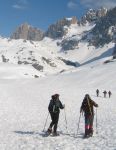 We could just say that snowshoeing is simply walking on snow without falling in, but that would be boring. Instead, with the help of our models Rachel and Alan, we thought we'd delve into the "art" of snowshoeing. You can click on any of the thumbnails on this page for larger images and a closer view of exactly what snowshoeing in the Picos de Europa entails. But first a few words about the necessary equipment.
We could just say that snowshoeing is simply walking on snow without falling in, but that would be boring. Instead, with the help of our models Rachel and Alan, we thought we'd delve into the "art" of snowshoeing. You can click on any of the thumbnails on this page for larger images and a closer view of exactly what snowshoeing in the Picos de Europa entails. But first a few words about the necessary equipment.
When most people think of snowshoeing they imagine an unwieldy, tennis racket-like appendage strapped to the foot, possibly with the odd husky or two bounding alongside (or, more likely, miles in front).  Modern snowshoes are actually much smaller than they imagine, narrow with bindings similar to those used for ski touring. You stick the toe of your boot into the front of the snowshoe where there is also a strap to tighten. The binding can be adjusted lengthways to fit the size of your boot. Your heel slots into the back where there's another strap to tie around your ankle so you don't lose the shoe if anything untoward happens! The back of the binding is free to move up and down as you walk, and to save stretching your calf tendons when walking uphill there's an added bonus of an optional "heel" which you can clip up. A bit like sticking on a pair of stilletoes. This simply clicks back down when the slope levels out. On the front underneath there's even a crampon for icy conditions. This slideshow shows snowshoes in more detail..........
Modern snowshoes are actually much smaller than they imagine, narrow with bindings similar to those used for ski touring. You stick the toe of your boot into the front of the snowshoe where there is also a strap to tighten. The binding can be adjusted lengthways to fit the size of your boot. Your heel slots into the back where there's another strap to tie around your ankle so you don't lose the shoe if anything untoward happens! The back of the binding is free to move up and down as you walk, and to save stretching your calf tendons when walking uphill there's an added bonus of an optional "heel" which you can clip up. A bit like sticking on a pair of stilletoes. This simply clicks back down when the slope levels out. On the front underneath there's even a crampon for icy conditions. This slideshow shows snowshoes in more detail..........
Back to our models, let's have a closer look at what the well-equipped snowshoer is wearing this season.  The observant among you will already have spotted the poles, essential for maintaining balance, helping to keep up a rhythmic pace as well as for testing the snow depth. Sensibly, Rachel and Alan have included gaiters in their personal clothing. (We can only assume that those rather large "day sacks" are carrying their fleeces, snowproof jackets and warm gloves). Our intrepid pair are obviously planning on making a summit or two, the ice axes strapped to their packs rather giving that game away. They may also be carrying their own flasks or water bottles of course, but shouldn't be carrying much food as we know their photographer/guide porters most of that. Here we can see that Rachel and Alan have escaped the "hordes" at the top of the cable car and are enjoying the tranquility of the Picos in winter.
The observant among you will already have spotted the poles, essential for maintaining balance, helping to keep up a rhythmic pace as well as for testing the snow depth. Sensibly, Rachel and Alan have included gaiters in their personal clothing. (We can only assume that those rather large "day sacks" are carrying their fleeces, snowproof jackets and warm gloves). Our intrepid pair are obviously planning on making a summit or two, the ice axes strapped to their packs rather giving that game away. They may also be carrying their own flasks or water bottles of course, but shouldn't be carrying much food as we know their photographer/guide porters most of that. Here we can see that Rachel and Alan have escaped the "hordes" at the top of the cable car and are enjoying the tranquility of the Picos in winter. They've easily mastered the snowshoe walking style of keeping their feet a little more apart than usual and can relax to soak in the views of this miniature, though magnificent, European mountain range.
They've easily mastered the snowshoe walking style of keeping their feet a little more apart than usual and can relax to soak in the views of this miniature, though magnificent, European mountain range.
Our strategically placed base near the old town of Potes allows for easy access to the main Cantabrian mountain chain, the Cordillera Cantábrica, when we want a change from the Picos themselves. Here the landscape is gentler with a more Scottish feel.
As with ski touring, snowshoeing has very little impact on the environment. We are much more likely to encounter indigenous wildlife than human while enjoying the isolated tranquility of being at one with nature. On the left, Rachel takes in the view under the south face of Peña Prieta, at 2,538m the highest peak in the Cordillera Cantábrica.
In these two images you can appreciate the geological differences between the peaks of the Picos de Europa (above) and the more rolling Cantabrian mountains (below).

See more of our snowshoeing images on the Picos Galleries.
Prices, Availability and Enquiries
From 675€ - 750€ pp.
(Booking for 1 person = 750€.
Booking for 2- 3 people = 712.50€. pp.
Booking for 4+ people = 675€ pp.)
Prices include:
- Transfers from Santander (see Travelling to the Picos de Europa)
- 7 nights full-board, en-suite accommodation inc. breakfasts and 3-course, home-cooked evening meals with beers and wine
- 6 full days of guided snowshoe walks inc. picnics
- Snowshoes and poles
- All transport during the week
The only extras are snacks and drinks out in bars and cable car tickets (@ 13€ one way).
You'll just need to bring walking boots, layers of clothing including a fleece and a waterproof outer layer, (gaiters are a good idea), sunglasses and suncream, a day pack and a flask and/or refillable water bottle.
For dates and availability go here.
Please send us an email to enquire
Or call, Whatsapp or text +34 660551307
- Article Count:
- 1
Self-Guided Holidays
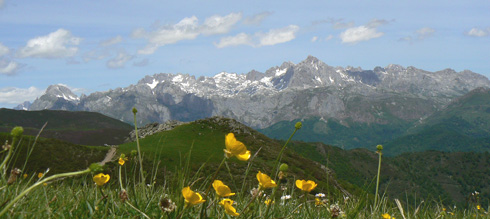
Picos Rock and Snow now offer fully-supported self-guided packages and/or bag transfers for independent travellers that would like to do linear or circular routes in and around the Picos de Europa and the Cantabrian coast. Logistics are no longer a headache!
Choose from;
Self-guided routes with options including;
- Transfer from the coast
- All accommodation booked ahead
- Trip notes and maps provided
- Packed lunches
- Daily bag transfers
- Telephone support
We currently have three different routes available. You pick your own dates and we will arrange the trip for you;
- Classic Traverse of the Central Massif
- Liébana Skyline Tour
- Camino de Santiago Detour (coming soon)
Take advantage of our bag transfer service. Using our services, you can walk comfortably with just a day pack while your bags are securely couriered ahead to the end of your route or your overnight stop.
Daily rates - From just 10€ per bag, up to 50 km's. Send us a message for a quote.

- Article Count:
- 2
Picos Rock and Snow Trip Reports
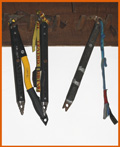
- Article Count:
- 0
Ski Touring and Mountaineering
- Article Count:
- 6
Snowshoeing Trip Reports
- Article Count:
- 1
Walking and Trekking Trip Reports
- Article Count:
- 2
The Picos Blog
 Our news from the mountains, including latest weather conditions.
Our news from the mountains, including latest weather conditions.
(See also our Trip Reports section)
- Article Count:
- 2
Ski touring
- Article Count:
- 11
Climbing
- Article Count:
- 4
Picos de Europa National Park

A combination of glaciation and karstification processes over a period of 300 million years has led to the present formation of the mostly limestone Picos de Europa mountains. The steeply jagged peaks have been separated from the Cantabrian mountain chain by, among other geological factors, glaciers forging their way around them, creating wide valleys on the peripheries while water erosion has further separated the soft rock into three massifs; the Western (el Cornión), the Central (los Urrieles) and the Eastern (Ándara). The river Cares divides the Western and Central Massifs and the river Duje splits the Central and Eastern. (Click on the relief map to enlarge). 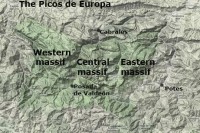
Some small lakes remain, although due to the porous nature of the rock there is very little superficial water in the Picos, the greatest volume of it being channelled underground through some of the deepest cave systems found in Europe today, much of which emerges lower down in the form of natural springs. A closer inspection of the surface limestone reveals the effect that acidic rain has on the rock, providing fantastic friction for walking and climbing and perfect niches for alpine plants. Sharp runnels become, as the water gouges deeper, clints, grikes and in places vast potholes, the latter making the Picos de Europa infamous for the dangers faced by walkers and mountaineers alike and known locally as "jous".
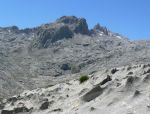
Its proximity to the sea, precisely the Atlantic ocean and the Bay of Biscay, explains why the Picos de Europa mountain range is particularly prone to sudden changes in weather; mists rolling in, clag appearing from nowhere, which can further complicate navigation. Legend has it that the mountains were named the Peaks of Europe by northern European sailors arriving by sea. On a clear day modern visitors crossing the Bay of Biscay, arriving by ferry into Santander, can appreciate the same view.
The Picos de Europa belong to three of Spain's Autonomous Communities, Asturias, Castilla León and Cantabria. The summit of Pico Tesorero (2,570m) in the Central Massif, is the point at which the three regions join. The highest summit in the Picos de Europa is Pico Torrecerredo at 2,648m in the Central Massif, Peña Santa at 2,596m is the highest in the Western and the Morra de Lechugales at 2,444m, the highest in the Eastern making the Picos de Europa the third highest mountain range of mainland Spain after the Pyrenees and the Sierra Nevada. The range includes 14 peaks over 2,600m. The most well-known of these mountains is Naranjo de Bulnes (2,519m), more commonly known as "Urriello" though more correctly named "El Pico Urriello", or in the Asturian dialect, "Picu Urriellu", or even more fondly, "El Picu". Naranjo means orange in Spanish and refers to the colour of the minerals showing on the rock. Bulnes is the nearest village, lying below.
the highest in the Eastern making the Picos de Europa the third highest mountain range of mainland Spain after the Pyrenees and the Sierra Nevada. The range includes 14 peaks over 2,600m. The most well-known of these mountains is Naranjo de Bulnes (2,519m), more commonly known as "Urriello" though more correctly named "El Pico Urriello", or in the Asturian dialect, "Picu Urriellu", or even more fondly, "El Picu". Naranjo means orange in Spanish and refers to the colour of the minerals showing on the rock. Bulnes is the nearest village, lying below.
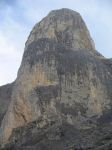 First created in 1918 to mark the 12th centenary of the Battle of Covadonga, the area originally given National Park status covered almost 17,000 ha. in the Western Massif only and was named "Parque Nacional de la Montaña de Covadonga" (National Park of the Covadonga Mountains). It wasn't until the 30th of May, 1995 that the Picos de Europa National Park was enlarged to finally encompass the other two massifs, causing not a little consternation among the farming community of the eastern sector concerned for the future of their traditional land management practices. It presently includes a total of 64,660 ha.
First created in 1918 to mark the 12th centenary of the Battle of Covadonga, the area originally given National Park status covered almost 17,000 ha. in the Western Massif only and was named "Parque Nacional de la Montaña de Covadonga" (National Park of the Covadonga Mountains). It wasn't until the 30th of May, 1995 that the Picos de Europa National Park was enlarged to finally encompass the other two massifs, causing not a little consternation among the farming community of the eastern sector concerned for the future of their traditional land management practices. It presently includes a total of 64,660 ha.
Conservation of the Picos is complicated further by the need to find a co-existence between nature and the unusually large number of the National Park's human inhabitants. Processes are currently underway to widen the park's area of socio-economic influence and the governing body, formerly the Spanish Ministry for the Environment, is to be devolved to be shared between the three 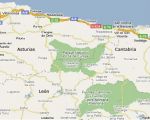 Autonomous Communities. Not surprisingly, this is causing concern among conservationists who perceive a lack of cohesion in its future management.
Autonomous Communities. Not surprisingly, this is causing concern among conservationists who perceive a lack of cohesion in its future management.
The Picos de Europa National Park has two large visitor's centres, "Pedro Pidal" in Cangas de Onis, Asturias and Sotama in the valley of Liébana, Cantabria as well as various smaller tourist information offices. The official website for the Picos de Europa National Park can be found here.
The limestone formation of the Picos de Europa, so close to the coast, with its eco-systems combining both mixed Atlantic (eg. Beech, Holm and Pyrenean oaks) and Mediterranean forest habitats (including Cork oak) alongside that of alpine pasture and man-managed hay meadows has led to international recognition and its inclusion in the European Union's Habitats Directive. From this it is included in the Natura 2000 network, from which springs its designation of Special Protection Areas (in Spanish, ZEPA's, Zonas de Especial Protección para las Aves) and Sites of Community Importance (in Spanish, LIC's, Lugares de Importancia Comunitaria). In July 2003 the Picos de Europa were made a Biosphere Reserve by UNESCO.

Of the wildlife found in the Picos, particularly noteworthy are; the Cantabrian Capercaillie, Tetrao urogallus cantabricus, a highly endangered bird dependent on a fragile habitat of ancient deciduous woods and heather-clad hillsides; the Cantabrian brown bear, Ursus arctos, also highly endangered and living in the high hilltops and woods of the surrounding valleys and an occasional visitor to the Picos themselves; the Iberian wolf, Canis lupus signatus, of which only a few small packs remain here; and the Cantabrian chamois, Rupicapra pyrenaica ssp.parva, the emblem of the Picos de Europa National Park. Other resident bird species include Griffon vulture, Gyps fulvus, Golden eagle, Aquila chrysaetos, and Black woodpecker, Dryocopus martius.
Browse the Picos Wildlife menus above on the right for detailed information on these species and more.

- Article Count:
- 0
Cares Gorge
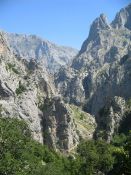
The clear, blue-green waters of the River Cares have gouged a deep ravine between the Central and Western massifs of the Picos de Europa. Between 1916 - 1925 a canal and path to service it were blown out of the cliff face to syphon off the waters to feed the hydro-electricity station in Poncebos. The path was reconditioned in 1946. Today, the Cares Gorge path is the most popular walk in the Picos de Europa and impossible to get lost on. Its 12 km length can be started either in the north end at Poncebos (pronounced Ponthayboss) in Asturias or in the south at Caín (pronounced Cayeen) in the province of León.
Stout walking boots or shoes are necessary as the stone path is loose in places. (Mike Stuart has been known to walk it in his slippers, but this is not recommended). A good head for heights is recommended however as although the path is mostly about 1,5m wide, in some parts its width shrinks to around 1m, making passing other walkers slightly precarious. Be prepared to repeat a hearty "Hola" regularly in the busy months of July and August. Other possible obstructions are the goats that live on the hillsides. At times the path is above the canal, at times below, and occasionally the two meet. As you near Caín, coming from Poncebos, there are a couple of bridges to cross before you enter a set of dripping, low-ceilinged tunnels that bring you to the dam. Set aside a whole day if you want to walk all of the gorge up and down, the only practical way without vehicle support at the other end, or unless you just want to walk in a little way then head back. From Poncebos at 218m to Caín at 460m the route takes from three to three and a half hours at a steady pace, the first half an hour or so being uphill. Knock off half an hour for the return journey.
Look out for birds; Dippers, Griffon vultures and Wallcreepers (the latter tend to be found at lower levels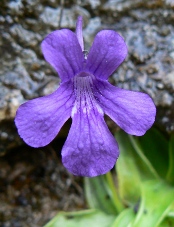 in autumn/winter) and flowering plants; the insectivorous Large-flowered butterwort (right) and Globularia vulgaris, while you keep one eye out for the very friendly goats that pasture in the gorge.
in autumn/winter) and flowering plants; the insectivorous Large-flowered butterwort (right) and Globularia vulgaris, while you keep one eye out for the very friendly goats that pasture in the gorge.
The slideshow below gives a virtual walk of the gorge, starting from Poncebos and ending at Caín, with many thanks to Steve Hartgrove for supplying the photos which were taken towards the end of May on a Picos Rock and Snow walking holiday in the Picos de Europa with Adventureline.
- Article Count:
- 1
Maps
- Article Count:
- 1
Huts and Refuges
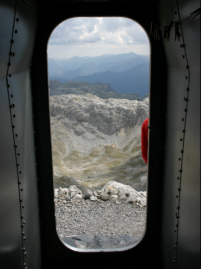
The Picos de Europa are fairly well served by mountain refuges, most being wardened just in the summer months.
- Article Count:
- 3
Travel
- Article Count:
- 1
Visitors Centres
- Article Count:
- 1
Uncategorised
- Article Count:
- 7









